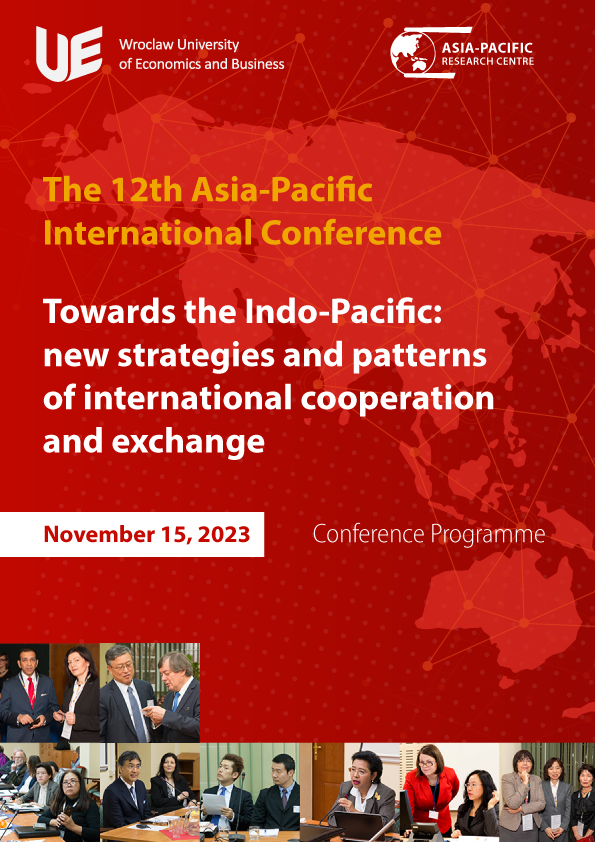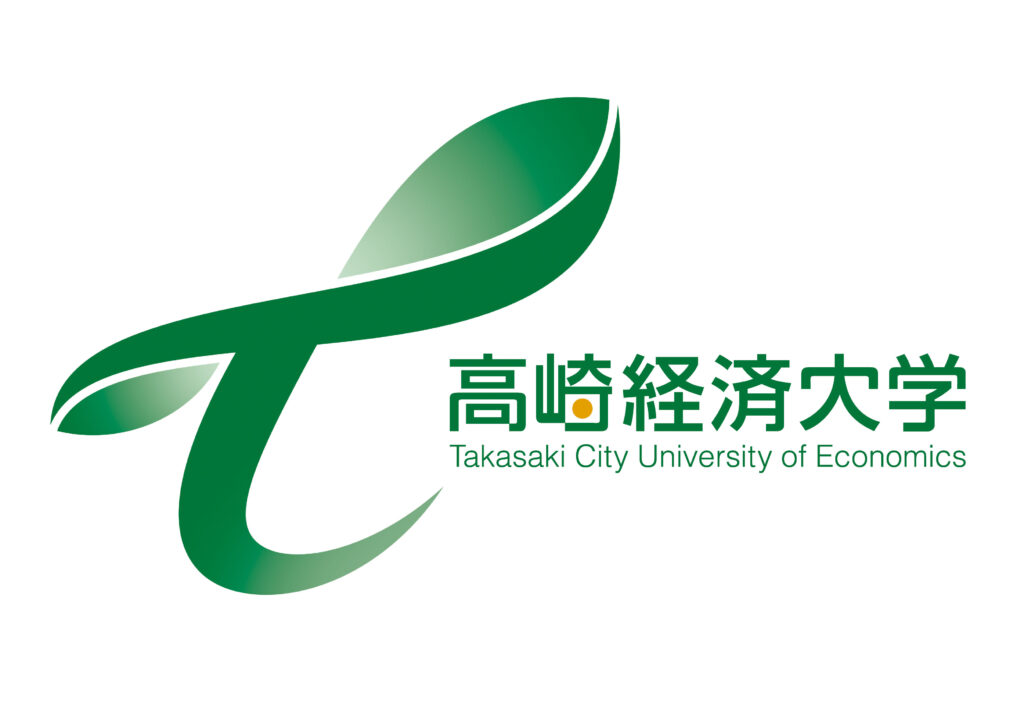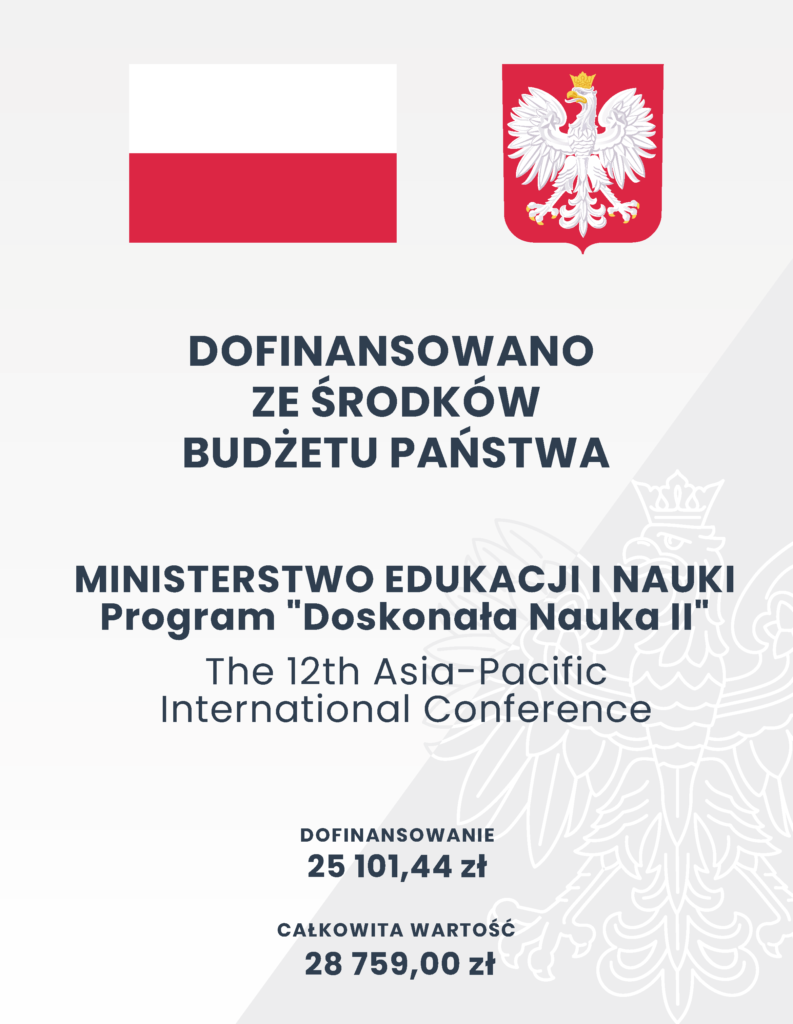Digital Session II (with presentations and discussion)
Zoom meeting: https://zoom.us/j/86378008193
Chair: dr hab. Artur Klimek, prof. UEW, Wroclaw University of Economics & Business, Poland
| Attractiveness of the Polish Investment Zone for Asian FDI, Dr. Jarosław Osmolak, Wroclaw University of Economics & Business, Poland | The article examines the five-year period (i.e. 2018-2023) of the operation of the Polish Investment Zone (PIZ), focusing on its investment attractiveness for Asian business projects. In the context of the increasing number of investments originating from Asia, especially from global corporations, the article highlights the positive outcomes of PIZ in attracting Japanese and Korean investors. The key factors for this success are the availability of attractive tax incentives and support from the public administration throughout the country. Data analysis indicates that Poland has become a preferred investment destination for many Asian companies, leading to a growth in investment over the past five years. Global corporations like LG and Daikin have chosen Poland as a strategic location, significantly enhancing the appeal of PIZ. These investments have not only benefitted the local economy but also contributed to the creation of new jobs and the transfer of technological know-how. Highly favorable tax conditions, including investment incentives and preferential tax rates offered by Polish SEZs, have played a pivotal role in attracting Asian investors. Furthermore, the availability of extensive public support across the country, encompassing infrastructure, qualified workforce, and access to European markets – are crucial factors in the decision-making process for investing in Poland by the Asian entrepreneurs. |
| Rethinking the measurement of specialization In GVCs: funtional specialization approach Dr. hab. Magdalena Olczyk, prof. PG, Gdańsk University of Technology, Poland | The emergence of global value chains has given rise to an ever more granular international division of labor with new opportunities for specialization. Differences between countries are not more due to specialization in different products or industries but because of specialization in different tasks in the same industries. This paper presents a new framework for understanding the phenomenon of functional specialization (FS), i.e., a new approach to measure the country specialization in GVCs. We measure FS in two ways: using the income share of workers engaged in activities in global value chains (Timmer et al., 2019) and using activities outsourced by firms through foreign direct investment (Stoellinger, 2021). Based on data for the period 2000-2018 for EU countries, we show crucial differences between EU15 and CEE countries in their FS patterns. High value-added activities are more likely to be located in the EU15 countries, while pure manufacturing is mainly located in the CEE countries. |
| Changing specialisation of China and India in global value chains between 1995 and 2020 Dr. Monika Wojtas, Maria Curie-Sklodowska University in Lublin, Poland Dr. hab. Tomasz Białowąs, Maria Curie-Sklodowska University in Lublin, Poland | The financial and economic crisis of 2008-2009 initiated a process of structural change in the global economy, which can include the weakening of production linkages and the transformations taking place in the geographical structure of value chains. These changes accelerated during the pandemic, and there are many indications that they will take on a long-term character. China is the central link in value chains in Asia, but both Chinese government policies and changes in the strategies of multinational corporations mean that its role is diminishing. On the other hand, India is gaining importance and becoming an increasingly crucial value-added supplier, both in the industrial sector and in services. The main objective of this article is to analyze the changes taking place in the specialization of China and India in global value chains in the post-1995 period. Specific objectives may include: 1) analyzing the strength of linkages in global value chains; 2) an assessment of changes in the geographic and subject structure of value-added trade; 3) assessing task specialisation; 4) identifying the main drivers of change. |
| Digital Nomads in Asia Marcin Majewski, Wroclaw University of Economics & Business, Poland | Digital nomadism mirrors the emerging trend among young individuals who embrace remote work to pursue their passions while exploring new destinations. The main research goal was to find out the determinant of the choice of Asia as a travel destination. The method of literature analysis and in-depth interviews on a sample of 10 respondents was used. The study showed that digital nomads choose to travel to Asia because of their interest in culture, low taxes, natural environment, and low cost of living. The research revealed that digital nomads often struggle to connect with a broader community due to misunderstandings and a lack of trust in the people they encounter while on their journeys. A typical digital nomad who works in the IT, marketing, or education industry is a young person looking for adventure while traveling and not paying much attention to housing conditions. Characteristic features are also minimalism and a reluctance to start a family. |
| Arab Countries in the Indo-Pacific in the Global Economy, Dr. Aleksandra Rabczun, Poznań University of Economic and Business, Poland | This presentation explores the role of Arab countries situated in the Indo-Pacific region within the context of the global economy. The Indo-Pacific has gained increasing significance as a pivotal area for international trade, investment, and geopolitical competition. Within this framework, Arab nations in the region play a multifaceted role, encompassing economic contributions, trade partnerships, and their unique position at the intersection of East and West. The presentation delves into the economic dynamics of these Arab nations, shedding light on their growth trajectories, economic diversification efforts, and the impact of regional and global trends on their economic landscapes. Additionally, it examines the geopolitical significance of these countries, considering their strategic alliances, energy resources, and their role as mediators in regional conflicts. Furthermore, the presentation evaluates the challenges and opportunities faced by Arab countries in the Indo-Pacific, with a focus on enhancing their competitiveness, fostering innovation, and navigating the evolving global economic order. It also addresses the prospects for increased cooperation between these nations and other stakeholders, both regionally and internationally. In conclusion, this presentation offers a comprehensive overview of the Arab countries in the Indo-Pacific and their evolving role in the global economy, highlighting their importance as key players in a rapidly changing economic and geopolitical landscape. |
| Strategic Responses From US Allies in Western Europe to the Rise of China Dr. Antonio José Pagán Sánchez, Universidad del Pacífico, Peru | The rise of China not only has an increasing impact on the global distribution of power but also on the very alliance between the United States and its European partners. It is paradoxical that, even though recent Chinese initiatives might undermine the Western structural power and the liberal international order over the long term, the main Western European allies of the United States have decided to support some of them, in spite of the critical stance of both Barack Obama and Donald Trump´s presidencies. Does this mean that China’s rise is opening a gap between the United States and its European allies? This paper will address this question through the analysis of the factors (economic opportunities, security concerns, and pressures exerted by the US) behind the diverging attitudes in the engagement with China of Germany, the United Kingdom, France, Italy, and Spain (the 5 European allies of the United States with the highest GDP and the largest economic contribution in absolute terms to NATO) in the following case studies: the Asia Infrastructure Investment Bank, the Belt and Road Initiative and the adoption of Huawei´s 5G technology. The results support the idea that security concerns are the main factor keeping US allies in Western Europe away from participating in certain Chinese initiatives and that such concerns on both sides of the Atlantic are increasingly converging, thus reducing the risks of an alliance drift between the two sides. |
| Participation in Global Value Chains on the Example of Asian and European Countries. A Comparative Study Dr. Anna H. Jankowiak, prof. UEW, Wroclaw University of Economics & Business, Poland | The vast majority of national economies are part of global value chains, although the scale of their participation and the possibility of creating chains is diverse. Some countries (especially from Africa or Central Asia) export raw materials for further processing, others import materials for assembly and export, and others produce highly innovative goods and services (mainly European or North American countries). Moreover, some countries are highly dependent on GVCs for trade, while others mainly export domestic goods for consumption. Highly developed countries and large emerging economies actively participate in global supply chains by producing advanced and innovative products and services. Other countries, especially those in Africa, Central Asia, and Latin America, participate in the GVC by producing semi-finished products that require further processing in other countries. The article aims to compare the participation in global value chains of European and Asian countries. Europe is a region with strong regional integration, which translates into four times more regional connections than global connections. In Europe, the regional fragmentation of value chains increased primarily due to the subsequent stages of European Union enlargement, during which the countries of Central and Eastern Europe, including Bulgaria, Hungary, and Poland, gradually joined the production networks of older members of the community. On the other hand, global fragmentation has also been important, driven mainly by larger European economies such as France, Germany, and the UK, whose links with Asian countries such as China and India have expanded rapidly in recent years. In Asia, however, the process of expanding GVC to countries at a medium and low level of regional development is observed, and the level of advancement of connections within the chains is very high. |
| Questions & Discussion |













